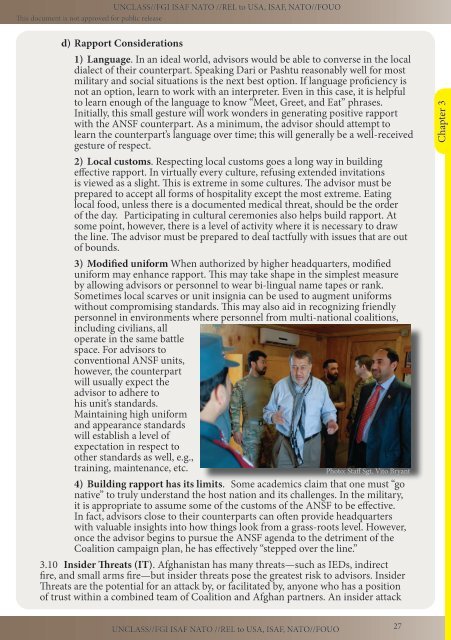20140927_NIU_CJ7_TREX_SFA guide 3.1
20140927_NIU_CJ7_TREX_SFA guide 3.1
20140927_NIU_CJ7_TREX_SFA guide 3.1
You also want an ePaper? Increase the reach of your titles
YUMPU automatically turns print PDFs into web optimized ePapers that Google loves.
UNCLASS//FGI ISAF NATO //REL to USA, ISAF, NATO//FOUO<br />
This document is not approved for public release<br />
d) Rapport Considerations<br />
1) Language. In an ideal world, advisors would be able to converse in the local<br />
dialect of their counterpart. Speaking Dari or Pashtu reasonably well for most<br />
military and social situations is the next best option. If language proficiency is<br />
not an option, learn to work with an interpreter. Even in this case, it is helpful<br />
to learn enough of the language to know “Meet, Greet, and Eat” phrases.<br />
Initially, this small gesture will work wonders in generating positive rapport<br />
with the ANSF counterpart. As a minimum, the advisor should attempt to<br />
learn the counterpart’s language over time; this will generally be a well-received<br />
gesture of respect.<br />
2) Local customs. Respecting local customs goes a long way in building<br />
effective rapport. In virtually every culture, refusing extended invitations<br />
is viewed as a slight. This is extreme in some cultures. The advisor must be<br />
prepared to accept all forms of hospitality except the most extreme. Eating<br />
local food, unless there is a documented medical threat, should be the order<br />
of the day. Participating in cultural ceremonies also helps build rapport. At<br />
some point, however, there is a level of activity where it is necessary to draw<br />
the line. The advisor must be prepared to deal tactfully with issues that are out<br />
of bounds.<br />
3) Modified uniform When authorized by higher headquarters, modified<br />
uniform may enhance rapport. This may take shape in the simplest measure<br />
by allowing advisors or personnel to wear bi-lingual name tapes or rank.<br />
Sometimes local scarves or unit insignia can be used to augment uniforms<br />
without compromising standards. This may also aid in recognizing friendly<br />
personnel in environments where personnel from multi-national coalitions,<br />
including civilians, all<br />
operate in the same battle<br />
space. For advisors to<br />
conventional ANSF units,<br />
however, the counterpart<br />
will usually expect the<br />
advisor to adhere to<br />
his unit’s standards.<br />
Maintaining high uniform<br />
and appearance standards<br />
will establish a level of<br />
expectation in respect to<br />
other standards as well, e.g.,<br />
training, maintenance, etc.<br />
Photo: Staff Sgt. Vito Bryant<br />
4) Building rapport has its limits. Some academics claim that one must “go<br />
native” to truly understand the host nation and its challenges. In the military,<br />
it is appropriate to assume some of the customs of the ANSF to be effective.<br />
In fact, advisors close to their counterparts can often provide headquarters<br />
with valuable insights into how things look from a grass-roots level. However,<br />
once the advisor begins to pursue the ANSF agenda to the detriment of the<br />
Coalition campaign plan, he has effectively “stepped over the line.”<br />
<strong>3.1</strong>0 Insider Threats (IT). Afghanistan has many threats—such as IEDs, indirect<br />
fire, and small arms fire—but insider threats pose the greatest risk to advisors. Insider<br />
Threats are the potential for an attack by, or facilitated by, anyone who has a position<br />
of trust within a combined team of Coalition and Afghan partners. An insider attack<br />
Chapter 3<br />
UNCLASS//FGI ISAF NATO //REL to USA, ISAF, NATO//FOUO<br />
27


